Effective Communication in Health and Social Care: An Analysis
VerifiedAdded on 2020/04/15
|9
|2169
|139
Essay
AI Summary
This essay delves into the critical role of effective communication within the health and social care domain. It begins by defining communication and highlighting its significance in fostering strong relationships between healthcare professionals and service users. The essay examines the key characteristics of effective communication, emphasizing the importance of two-way processes, understanding the needs of the environment, and adapting to language and cultural barriers. Relevant theoretical concepts, such as verbal and non-verbal communication, are discussed, alongside different forms of communication including formal, informal, one-to-one, and group settings. A personal reflection on the author's experiences with a patient suffering from dementia is provided, illustrating the practical impact of effective communication in delivering personalized care and building trust. The essay also addresses barriers to communication, such as sensory deprivation and cultural differences, and suggests strategies to overcome these challenges. The conclusion emphasizes the multidimensional benefits of effective communication, underscoring its role in building relationships, understanding patients, and adapting communication styles to various clinical contexts. The essay recommends reflection on personal experiences to enhance communication skills. The essay includes references to support the claims and findings.
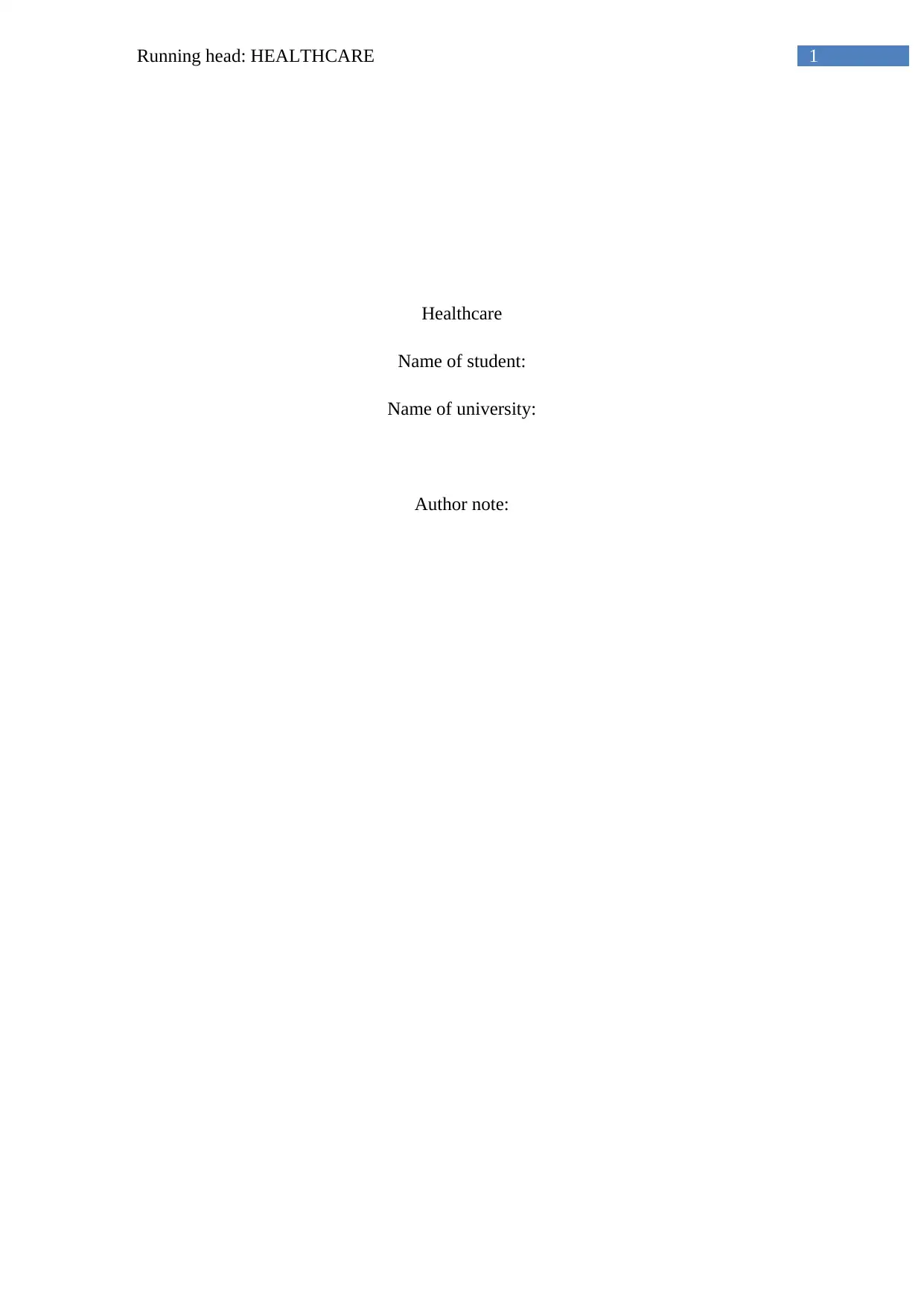
1Running head: HEALTHCARE
Healthcare
Name of student:
Name of university:
Author note:
Healthcare
Name of student:
Name of university:
Author note:
Paraphrase This Document
Need a fresh take? Get an instant paraphrase of this document with our AI Paraphraser
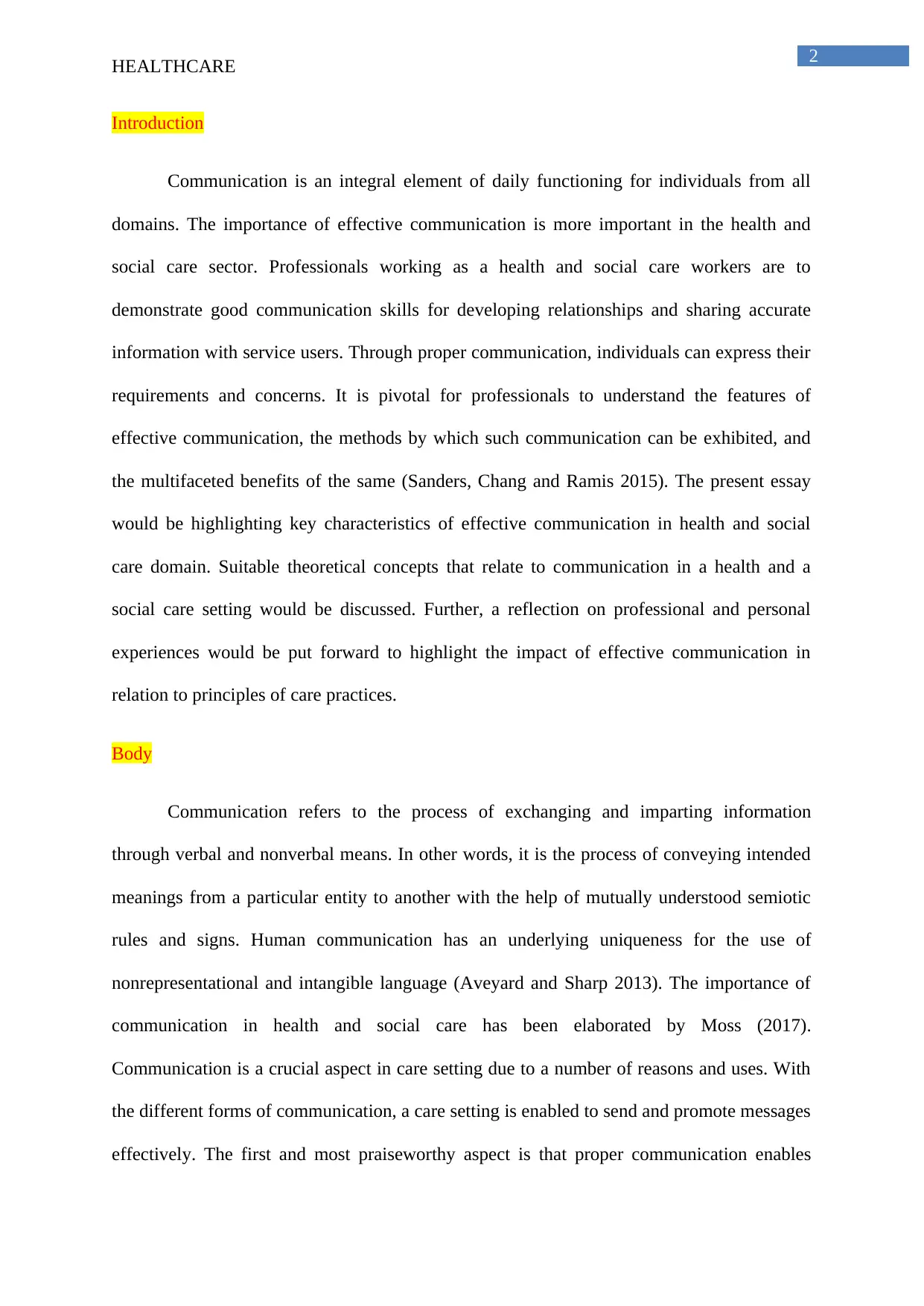
2
HEALTHCARE
Introduction
Communication is an integral element of daily functioning for individuals from all
domains. The importance of effective communication is more important in the health and
social care sector. Professionals working as a health and social care workers are to
demonstrate good communication skills for developing relationships and sharing accurate
information with service users. Through proper communication, individuals can express their
requirements and concerns. It is pivotal for professionals to understand the features of
effective communication, the methods by which such communication can be exhibited, and
the multifaceted benefits of the same (Sanders, Chang and Ramis 2015). The present essay
would be highlighting key characteristics of effective communication in health and social
care domain. Suitable theoretical concepts that relate to communication in a health and a
social care setting would be discussed. Further, a reflection on professional and personal
experiences would be put forward to highlight the impact of effective communication in
relation to principles of care practices.
Body
Communication refers to the process of exchanging and imparting information
through verbal and nonverbal means. In other words, it is the process of conveying intended
meanings from a particular entity to another with the help of mutually understood semiotic
rules and signs. Human communication has an underlying uniqueness for the use of
nonrepresentational and intangible language (Aveyard and Sharp 2013). The importance of
communication in health and social care has been elaborated by Moss (2017).
Communication is a crucial aspect in care setting due to a number of reasons and uses. With
the different forms of communication, a care setting is enabled to send and promote messages
effectively. The first and most praiseworthy aspect is that proper communication enables
HEALTHCARE
Introduction
Communication is an integral element of daily functioning for individuals from all
domains. The importance of effective communication is more important in the health and
social care sector. Professionals working as a health and social care workers are to
demonstrate good communication skills for developing relationships and sharing accurate
information with service users. Through proper communication, individuals can express their
requirements and concerns. It is pivotal for professionals to understand the features of
effective communication, the methods by which such communication can be exhibited, and
the multifaceted benefits of the same (Sanders, Chang and Ramis 2015). The present essay
would be highlighting key characteristics of effective communication in health and social
care domain. Suitable theoretical concepts that relate to communication in a health and a
social care setting would be discussed. Further, a reflection on professional and personal
experiences would be put forward to highlight the impact of effective communication in
relation to principles of care practices.
Body
Communication refers to the process of exchanging and imparting information
through verbal and nonverbal means. In other words, it is the process of conveying intended
meanings from a particular entity to another with the help of mutually understood semiotic
rules and signs. Human communication has an underlying uniqueness for the use of
nonrepresentational and intangible language (Aveyard and Sharp 2013). The importance of
communication in health and social care has been elaborated by Moss (2017).
Communication is a crucial aspect in care setting due to a number of reasons and uses. With
the different forms of communication, a care setting is enabled to send and promote messages
effectively. The first and most praiseworthy aspect is that proper communication enables
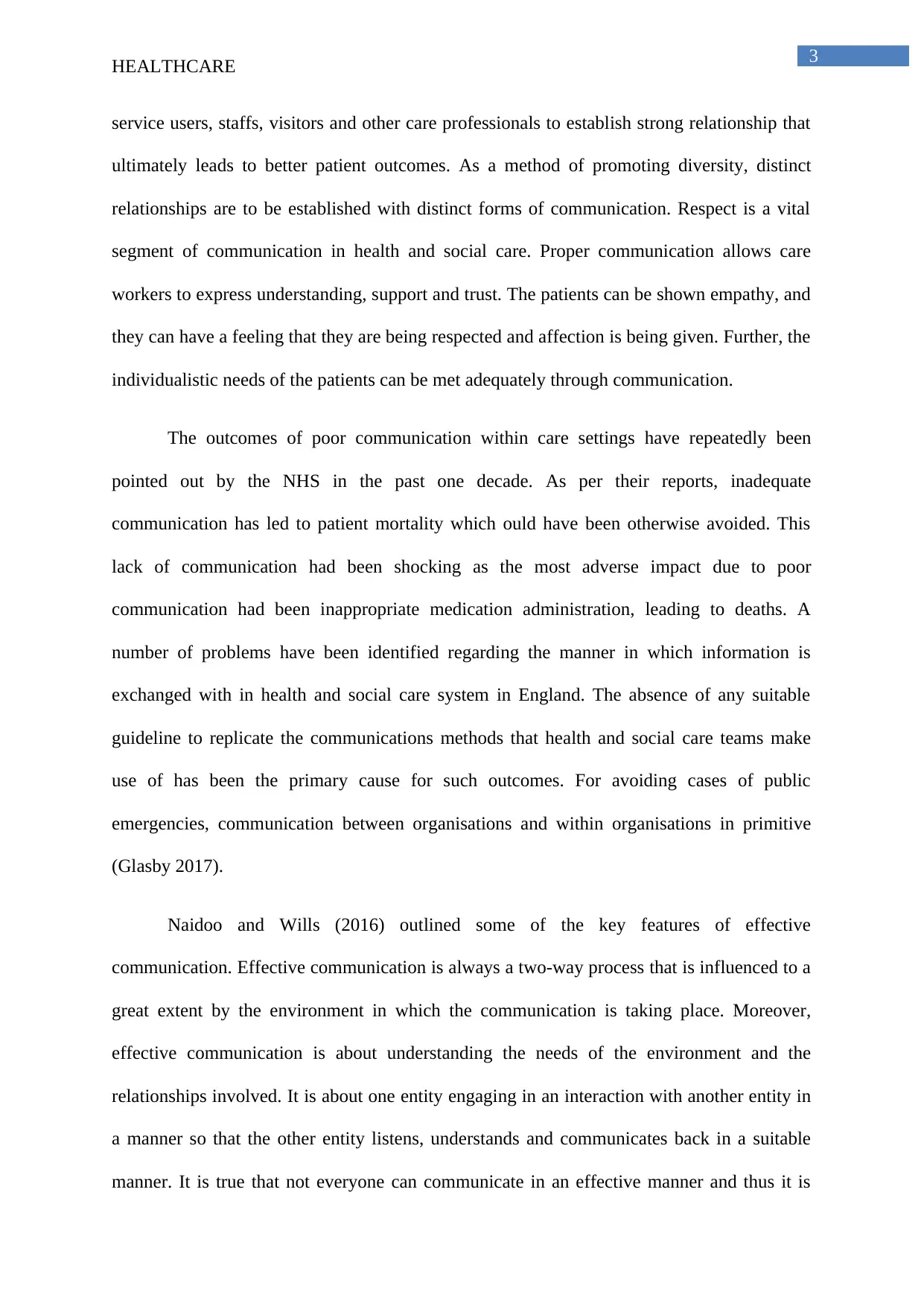
3
HEALTHCARE
service users, staffs, visitors and other care professionals to establish strong relationship that
ultimately leads to better patient outcomes. As a method of promoting diversity, distinct
relationships are to be established with distinct forms of communication. Respect is a vital
segment of communication in health and social care. Proper communication allows care
workers to express understanding, support and trust. The patients can be shown empathy, and
they can have a feeling that they are being respected and affection is being given. Further, the
individualistic needs of the patients can be met adequately through communication.
The outcomes of poor communication within care settings have repeatedly been
pointed out by the NHS in the past one decade. As per their reports, inadequate
communication has led to patient mortality which ould have been otherwise avoided. This
lack of communication had been shocking as the most adverse impact due to poor
communication had been inappropriate medication administration, leading to deaths. A
number of problems have been identified regarding the manner in which information is
exchanged with in health and social care system in England. The absence of any suitable
guideline to replicate the communications methods that health and social care teams make
use of has been the primary cause for such outcomes. For avoiding cases of public
emergencies, communication between organisations and within organisations in primitive
(Glasby 2017).
Naidoo and Wills (2016) outlined some of the key features of effective
communication. Effective communication is always a two-way process that is influenced to a
great extent by the environment in which the communication is taking place. Moreover,
effective communication is about understanding the needs of the environment and the
relationships involved. It is about one entity engaging in an interaction with another entity in
a manner so that the other entity listens, understands and communicates back in a suitable
manner. It is true that not everyone can communicate in an effective manner and thus it is
HEALTHCARE
service users, staffs, visitors and other care professionals to establish strong relationship that
ultimately leads to better patient outcomes. As a method of promoting diversity, distinct
relationships are to be established with distinct forms of communication. Respect is a vital
segment of communication in health and social care. Proper communication allows care
workers to express understanding, support and trust. The patients can be shown empathy, and
they can have a feeling that they are being respected and affection is being given. Further, the
individualistic needs of the patients can be met adequately through communication.
The outcomes of poor communication within care settings have repeatedly been
pointed out by the NHS in the past one decade. As per their reports, inadequate
communication has led to patient mortality which ould have been otherwise avoided. This
lack of communication had been shocking as the most adverse impact due to poor
communication had been inappropriate medication administration, leading to deaths. A
number of problems have been identified regarding the manner in which information is
exchanged with in health and social care system in England. The absence of any suitable
guideline to replicate the communications methods that health and social care teams make
use of has been the primary cause for such outcomes. For avoiding cases of public
emergencies, communication between organisations and within organisations in primitive
(Glasby 2017).
Naidoo and Wills (2016) outlined some of the key features of effective
communication. Effective communication is always a two-way process that is influenced to a
great extent by the environment in which the communication is taking place. Moreover,
effective communication is about understanding the needs of the environment and the
relationships involved. It is about one entity engaging in an interaction with another entity in
a manner so that the other entity listens, understands and communicates back in a suitable
manner. It is true that not everyone can communicate in an effective manner and thus it is
⊘ This is a preview!⊘
Do you want full access?
Subscribe today to unlock all pages.

Trusted by 1+ million students worldwide
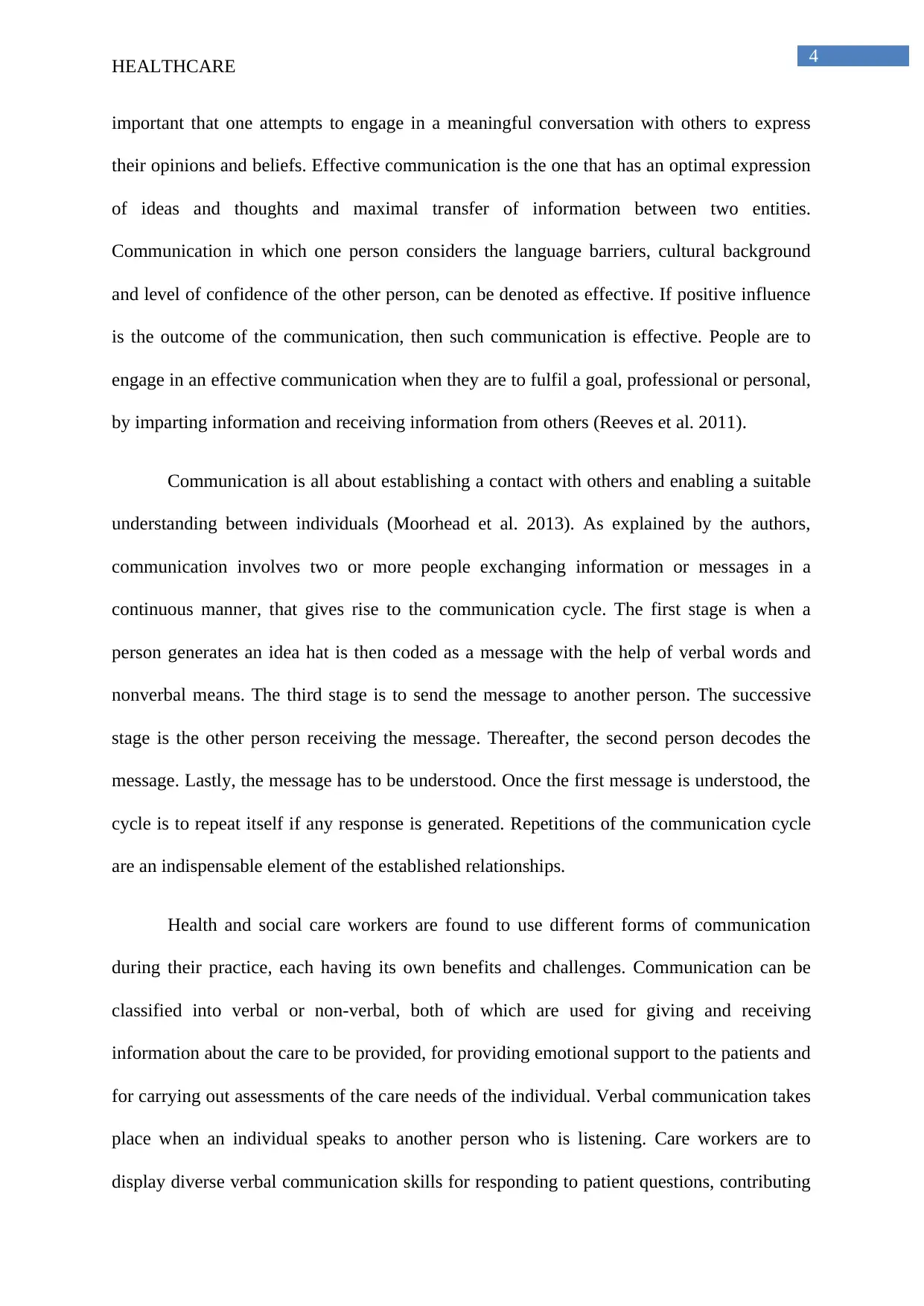
4
HEALTHCARE
important that one attempts to engage in a meaningful conversation with others to express
their opinions and beliefs. Effective communication is the one that has an optimal expression
of ideas and thoughts and maximal transfer of information between two entities.
Communication in which one person considers the language barriers, cultural background
and level of confidence of the other person, can be denoted as effective. If positive influence
is the outcome of the communication, then such communication is effective. People are to
engage in an effective communication when they are to fulfil a goal, professional or personal,
by imparting information and receiving information from others (Reeves et al. 2011).
Communication is all about establishing a contact with others and enabling a suitable
understanding between individuals (Moorhead et al. 2013). As explained by the authors,
communication involves two or more people exchanging information or messages in a
continuous manner, that gives rise to the communication cycle. The first stage is when a
person generates an idea hat is then coded as a message with the help of verbal words and
nonverbal means. The third stage is to send the message to another person. The successive
stage is the other person receiving the message. Thereafter, the second person decodes the
message. Lastly, the message has to be understood. Once the first message is understood, the
cycle is to repeat itself if any response is generated. Repetitions of the communication cycle
are an indispensable element of the established relationships.
Health and social care workers are found to use different forms of communication
during their practice, each having its own benefits and challenges. Communication can be
classified into verbal or non-verbal, both of which are used for giving and receiving
information about the care to be provided, for providing emotional support to the patients and
for carrying out assessments of the care needs of the individual. Verbal communication takes
place when an individual speaks to another person who is listening. Care workers are to
display diverse verbal communication skills for responding to patient questions, contributing
HEALTHCARE
important that one attempts to engage in a meaningful conversation with others to express
their opinions and beliefs. Effective communication is the one that has an optimal expression
of ideas and thoughts and maximal transfer of information between two entities.
Communication in which one person considers the language barriers, cultural background
and level of confidence of the other person, can be denoted as effective. If positive influence
is the outcome of the communication, then such communication is effective. People are to
engage in an effective communication when they are to fulfil a goal, professional or personal,
by imparting information and receiving information from others (Reeves et al. 2011).
Communication is all about establishing a contact with others and enabling a suitable
understanding between individuals (Moorhead et al. 2013). As explained by the authors,
communication involves two or more people exchanging information or messages in a
continuous manner, that gives rise to the communication cycle. The first stage is when a
person generates an idea hat is then coded as a message with the help of verbal words and
nonverbal means. The third stage is to send the message to another person. The successive
stage is the other person receiving the message. Thereafter, the second person decodes the
message. Lastly, the message has to be understood. Once the first message is understood, the
cycle is to repeat itself if any response is generated. Repetitions of the communication cycle
are an indispensable element of the established relationships.
Health and social care workers are found to use different forms of communication
during their practice, each having its own benefits and challenges. Communication can be
classified into verbal or non-verbal, both of which are used for giving and receiving
information about the care to be provided, for providing emotional support to the patients and
for carrying out assessments of the care needs of the individual. Verbal communication takes
place when an individual speaks to another person who is listening. Care workers are to
display diverse verbal communication skills for responding to patient questions, contributing
Paraphrase This Document
Need a fresh take? Get an instant paraphrase of this document with our AI Paraphraser
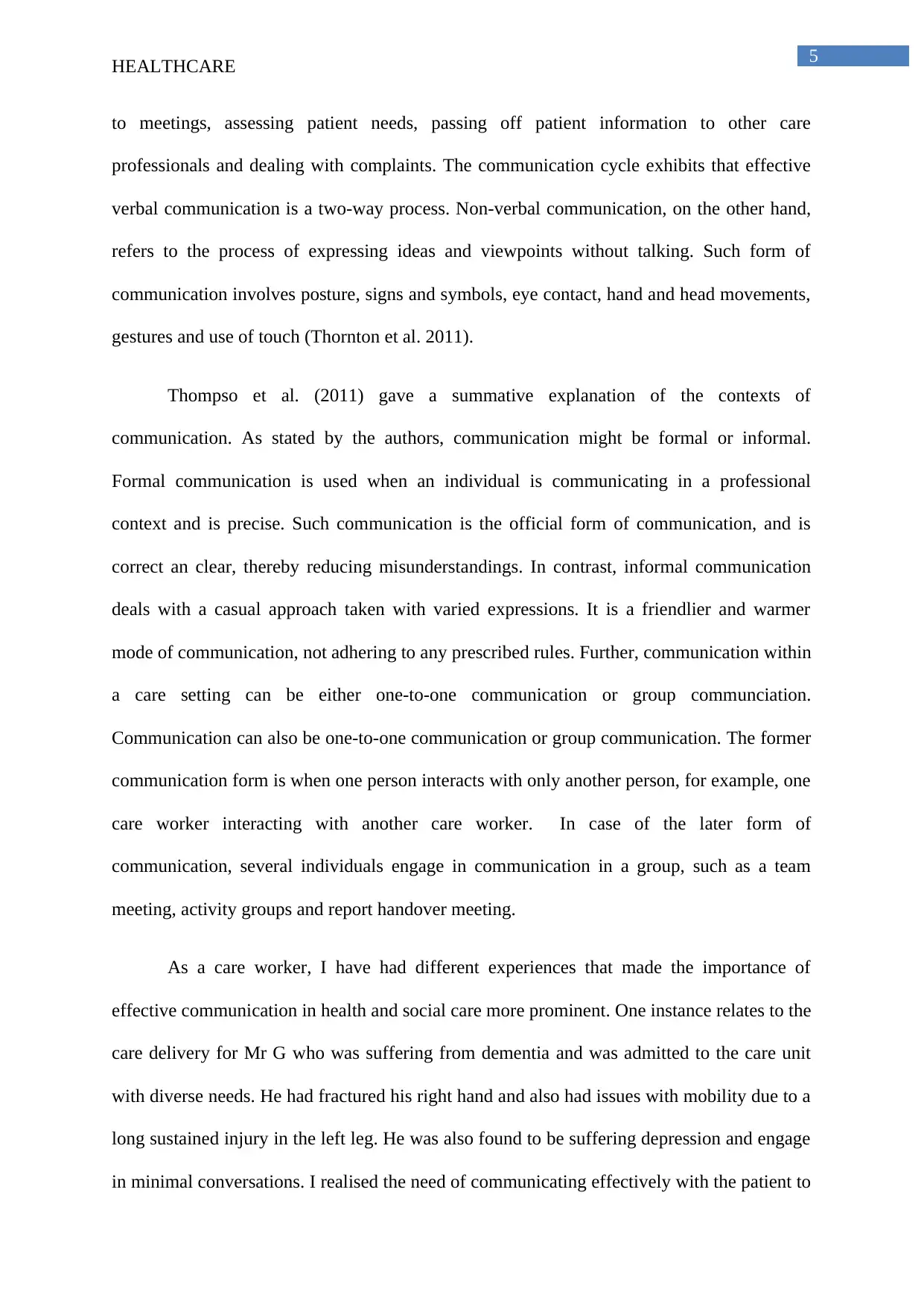
5
HEALTHCARE
to meetings, assessing patient needs, passing off patient information to other care
professionals and dealing with complaints. The communication cycle exhibits that effective
verbal communication is a two-way process. Non-verbal communication, on the other hand,
refers to the process of expressing ideas and viewpoints without talking. Such form of
communication involves posture, signs and symbols, eye contact, hand and head movements,
gestures and use of touch (Thornton et al. 2011).
Thompso et al. (2011) gave a summative explanation of the contexts of
communication. As stated by the authors, communication might be formal or informal.
Formal communication is used when an individual is communicating in a professional
context and is precise. Such communication is the official form of communication, and is
correct an clear, thereby reducing misunderstandings. In contrast, informal communication
deals with a casual approach taken with varied expressions. It is a friendlier and warmer
mode of communication, not adhering to any prescribed rules. Further, communication within
a care setting can be either one-to-one communication or group communciation.
Communication can also be one-to-one communication or group communication. The former
communication form is when one person interacts with only another person, for example, one
care worker interacting with another care worker. In case of the later form of
communication, several individuals engage in communication in a group, such as a team
meeting, activity groups and report handover meeting.
As a care worker, I have had different experiences that made the importance of
effective communication in health and social care more prominent. One instance relates to the
care delivery for Mr G who was suffering from dementia and was admitted to the care unit
with diverse needs. He had fractured his right hand and also had issues with mobility due to a
long sustained injury in the left leg. He was also found to be suffering depression and engage
in minimal conversations. I realised the need of communicating effectively with the patient to
HEALTHCARE
to meetings, assessing patient needs, passing off patient information to other care
professionals and dealing with complaints. The communication cycle exhibits that effective
verbal communication is a two-way process. Non-verbal communication, on the other hand,
refers to the process of expressing ideas and viewpoints without talking. Such form of
communication involves posture, signs and symbols, eye contact, hand and head movements,
gestures and use of touch (Thornton et al. 2011).
Thompso et al. (2011) gave a summative explanation of the contexts of
communication. As stated by the authors, communication might be formal or informal.
Formal communication is used when an individual is communicating in a professional
context and is precise. Such communication is the official form of communication, and is
correct an clear, thereby reducing misunderstandings. In contrast, informal communication
deals with a casual approach taken with varied expressions. It is a friendlier and warmer
mode of communication, not adhering to any prescribed rules. Further, communication within
a care setting can be either one-to-one communication or group communciation.
Communication can also be one-to-one communication or group communication. The former
communication form is when one person interacts with only another person, for example, one
care worker interacting with another care worker. In case of the later form of
communication, several individuals engage in communication in a group, such as a team
meeting, activity groups and report handover meeting.
As a care worker, I have had different experiences that made the importance of
effective communication in health and social care more prominent. One instance relates to the
care delivery for Mr G who was suffering from dementia and was admitted to the care unit
with diverse needs. He had fractured his right hand and also had issues with mobility due to a
long sustained injury in the left leg. He was also found to be suffering depression and engage
in minimal conversations. I realised the need of communicating effectively with the patient to
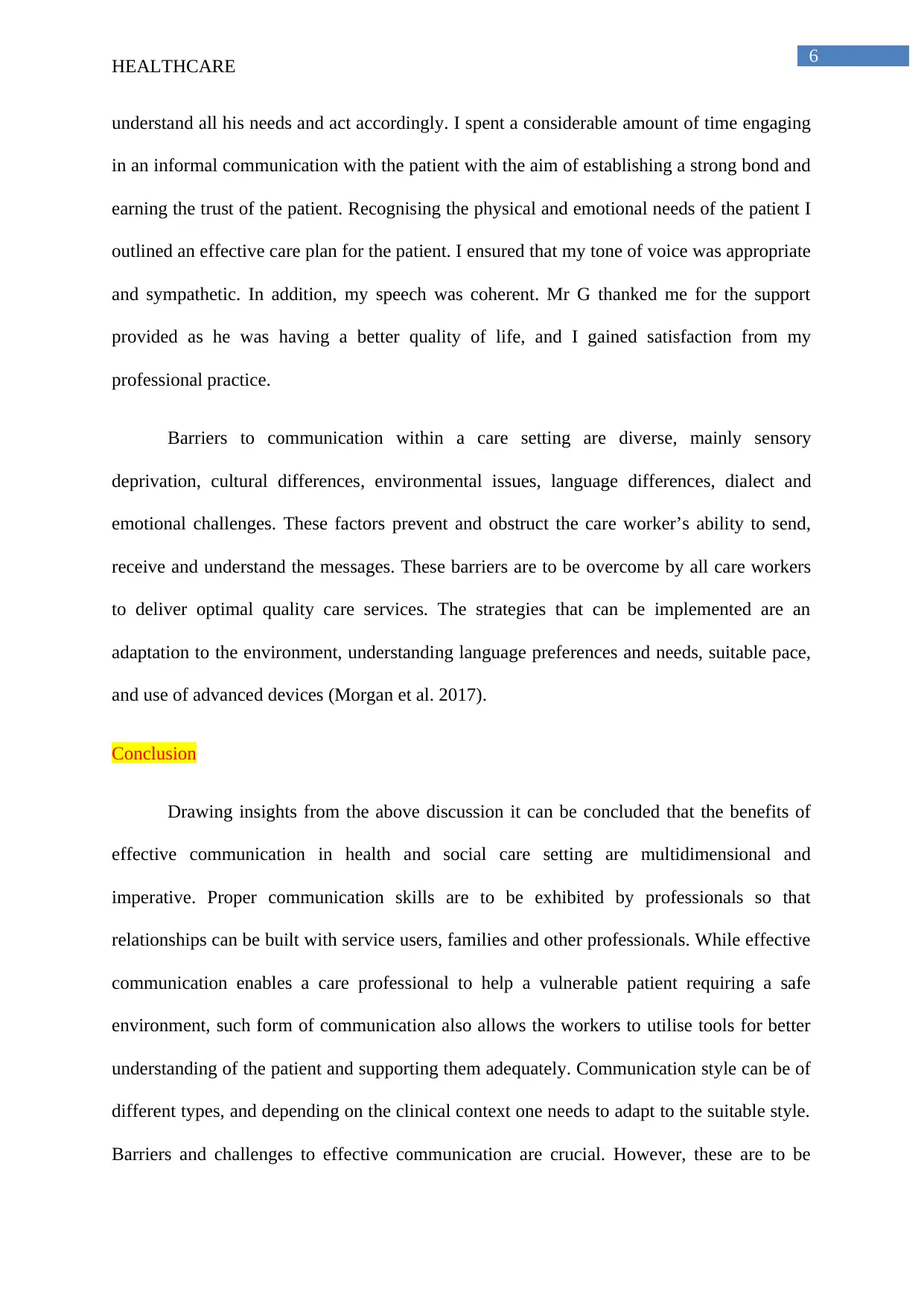
6
HEALTHCARE
understand all his needs and act accordingly. I spent a considerable amount of time engaging
in an informal communication with the patient with the aim of establishing a strong bond and
earning the trust of the patient. Recognising the physical and emotional needs of the patient I
outlined an effective care plan for the patient. I ensured that my tone of voice was appropriate
and sympathetic. In addition, my speech was coherent. Mr G thanked me for the support
provided as he was having a better quality of life, and I gained satisfaction from my
professional practice.
Barriers to communication within a care setting are diverse, mainly sensory
deprivation, cultural differences, environmental issues, language differences, dialect and
emotional challenges. These factors prevent and obstruct the care worker’s ability to send,
receive and understand the messages. These barriers are to be overcome by all care workers
to deliver optimal quality care services. The strategies that can be implemented are an
adaptation to the environment, understanding language preferences and needs, suitable pace,
and use of advanced devices (Morgan et al. 2017).
Conclusion
Drawing insights from the above discussion it can be concluded that the benefits of
effective communication in health and social care setting are multidimensional and
imperative. Proper communication skills are to be exhibited by professionals so that
relationships can be built with service users, families and other professionals. While effective
communication enables a care professional to help a vulnerable patient requiring a safe
environment, such form of communication also allows the workers to utilise tools for better
understanding of the patient and supporting them adequately. Communication style can be of
different types, and depending on the clinical context one needs to adapt to the suitable style.
Barriers and challenges to effective communication are crucial. However, these are to be
HEALTHCARE
understand all his needs and act accordingly. I spent a considerable amount of time engaging
in an informal communication with the patient with the aim of establishing a strong bond and
earning the trust of the patient. Recognising the physical and emotional needs of the patient I
outlined an effective care plan for the patient. I ensured that my tone of voice was appropriate
and sympathetic. In addition, my speech was coherent. Mr G thanked me for the support
provided as he was having a better quality of life, and I gained satisfaction from my
professional practice.
Barriers to communication within a care setting are diverse, mainly sensory
deprivation, cultural differences, environmental issues, language differences, dialect and
emotional challenges. These factors prevent and obstruct the care worker’s ability to send,
receive and understand the messages. These barriers are to be overcome by all care workers
to deliver optimal quality care services. The strategies that can be implemented are an
adaptation to the environment, understanding language preferences and needs, suitable pace,
and use of advanced devices (Morgan et al. 2017).
Conclusion
Drawing insights from the above discussion it can be concluded that the benefits of
effective communication in health and social care setting are multidimensional and
imperative. Proper communication skills are to be exhibited by professionals so that
relationships can be built with service users, families and other professionals. While effective
communication enables a care professional to help a vulnerable patient requiring a safe
environment, such form of communication also allows the workers to utilise tools for better
understanding of the patient and supporting them adequately. Communication style can be of
different types, and depending on the clinical context one needs to adapt to the suitable style.
Barriers and challenges to effective communication are crucial. However, these are to be
⊘ This is a preview!⊘
Do you want full access?
Subscribe today to unlock all pages.

Trusted by 1+ million students worldwide

7
HEALTHCARE
avoided through different techniques that are apt for care context. Lastly, care professionals
need to reflect on their own experiences and consider enhancing their communication styles
based on the weaknesses identified. For this purpose, maximal resource utilisation would be
essential.
HEALTHCARE
avoided through different techniques that are apt for care context. Lastly, care professionals
need to reflect on their own experiences and consider enhancing their communication styles
based on the weaknesses identified. For this purpose, maximal resource utilisation would be
essential.
Paraphrase This Document
Need a fresh take? Get an instant paraphrase of this document with our AI Paraphraser

8
HEALTHCARE
References
Aveyard, H. and Sharp, P., 2013. A beginner's guide to evidence-based practice in health and
social care. McGraw-Hill Education (UK).
Glasby, J., 2017. Understanding health and social care. Policy Press.
Moorhead, S.A., Hazlett, D.E., Harrison, L., Carroll, J.K., Irwin, A. and Hoving, C., 2013. A
new dimension of health care: systematic review of the uses, benefits, and limitations of
social media for health communication. Journal of medical Internet research, 15(4).
Morgan, H.M., Entwistle, V.A., Cribb, A., Christmas, S., Owens, J., Skea, Z.C. and Watt,
I.S., 2017. We need to talk about purpose: a critical interpretive synthesis of health and social
care professionals’ approaches to self‐management support for people with long‐term
conditions. Health Expectations, 20(2), pp.243-259.
Moss, B., 2017. Communication skills in health and social care. Sage.
Naidoo, J. and Wills, J., 2016. Foundations for Health Promotion-E-Book. Elsevier Health
Sciences.
Reeves, S., Lewin, S., Espin, S. and Zwarenstein, M., 2011. Interprofessional teamwork for
health and social care (Vol. 8). John Wiley & Sons.
Sanders, L., Chang, A. and Ramis, M.A., 2015. The effectiveness of communication
interventions in providing older people with information on access to in‐home health and
social care services: a systematic review protocol. JBI database of systematic reviews and
implementation reports, 13(5), pp.105-117.
Thompson, T.L., Parrott, R. and Nussbaum, J.F. eds., 2011. The Routledge handbook of
health communication. Routledge.
HEALTHCARE
References
Aveyard, H. and Sharp, P., 2013. A beginner's guide to evidence-based practice in health and
social care. McGraw-Hill Education (UK).
Glasby, J., 2017. Understanding health and social care. Policy Press.
Moorhead, S.A., Hazlett, D.E., Harrison, L., Carroll, J.K., Irwin, A. and Hoving, C., 2013. A
new dimension of health care: systematic review of the uses, benefits, and limitations of
social media for health communication. Journal of medical Internet research, 15(4).
Morgan, H.M., Entwistle, V.A., Cribb, A., Christmas, S., Owens, J., Skea, Z.C. and Watt,
I.S., 2017. We need to talk about purpose: a critical interpretive synthesis of health and social
care professionals’ approaches to self‐management support for people with long‐term
conditions. Health Expectations, 20(2), pp.243-259.
Moss, B., 2017. Communication skills in health and social care. Sage.
Naidoo, J. and Wills, J., 2016. Foundations for Health Promotion-E-Book. Elsevier Health
Sciences.
Reeves, S., Lewin, S., Espin, S. and Zwarenstein, M., 2011. Interprofessional teamwork for
health and social care (Vol. 8). John Wiley & Sons.
Sanders, L., Chang, A. and Ramis, M.A., 2015. The effectiveness of communication
interventions in providing older people with information on access to in‐home health and
social care services: a systematic review protocol. JBI database of systematic reviews and
implementation reports, 13(5), pp.105-117.
Thompson, T.L., Parrott, R. and Nussbaum, J.F. eds., 2011. The Routledge handbook of
health communication. Routledge.
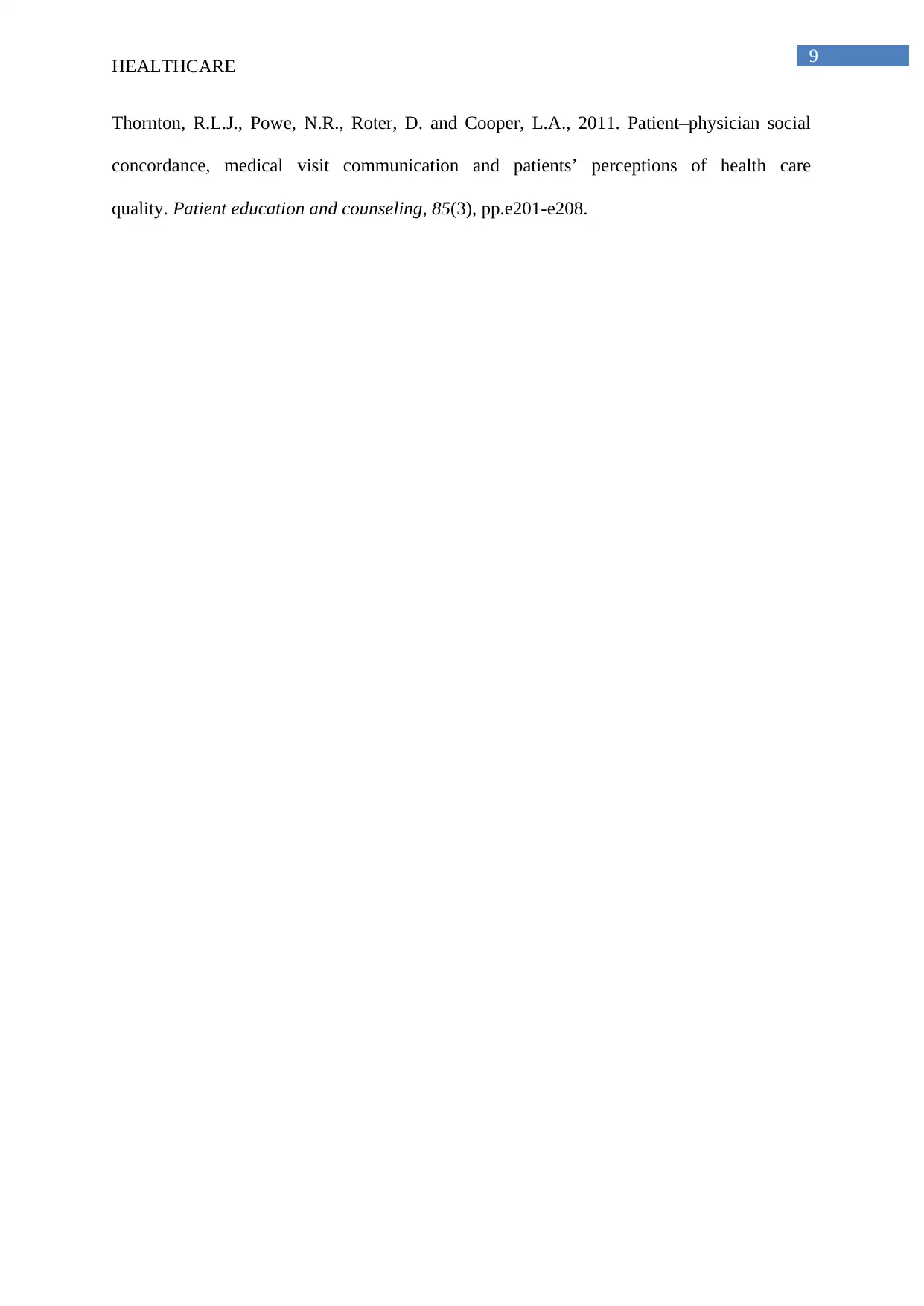
9
HEALTHCARE
Thornton, R.L.J., Powe, N.R., Roter, D. and Cooper, L.A., 2011. Patient–physician social
concordance, medical visit communication and patients’ perceptions of health care
quality. Patient education and counseling, 85(3), pp.e201-e208.
HEALTHCARE
Thornton, R.L.J., Powe, N.R., Roter, D. and Cooper, L.A., 2011. Patient–physician social
concordance, medical visit communication and patients’ perceptions of health care
quality. Patient education and counseling, 85(3), pp.e201-e208.
⊘ This is a preview!⊘
Do you want full access?
Subscribe today to unlock all pages.

Trusted by 1+ million students worldwide
1 out of 9
Related Documents
Your All-in-One AI-Powered Toolkit for Academic Success.
+13062052269
info@desklib.com
Available 24*7 on WhatsApp / Email
![[object Object]](/_next/static/media/star-bottom.7253800d.svg)
Unlock your academic potential
Copyright © 2020–2025 A2Z Services. All Rights Reserved. Developed and managed by ZUCOL.




